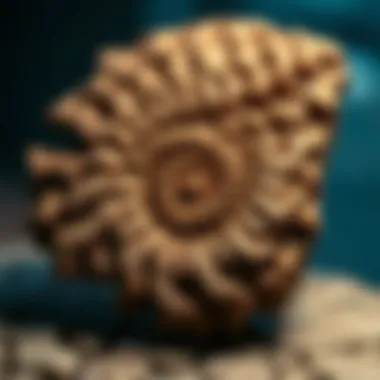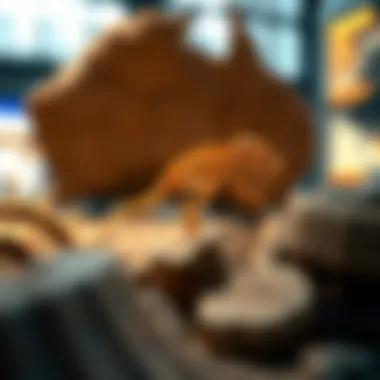Exploring Australia's Fossil Market: Trends and Insights


Intro
The allure of fossils extends far beyond mere rock and mineral enthusiasts. For many, it’s a passionate pursuit that intertwines scientific curiosity with the thrill of discovery. In Australia, the fossil market is blossoming, with myriad species of ancient life waiting to be uncovered and cherished by collectors and researchers alike. But with this passionate endeavor comes responsibility and legalities that must be navigated.
Understanding the Australian fossil market, its trends, regulations, and best collecting practices fosters a deeper appreciation not just for these remnants of the past, but also for the natural history they encapsulate. This article takes you through essential aspects of fossil collecting in Australia, providing insights that might otherwise be overlooked.
History and Origins
Overview of Collectibles, Rocks, and Fossils
Fossils have fascinated humans for centuries, an interest that transcends cultural boundaries. In Australia, the allure of these geological treasures runs deep. When we talk about collectibles, fossils are unique slices of time; they are physical evidence of life long gone, embedded in stone. The journey of fossil collecting in Australia can be traced back to early settlers who stumbled upon fossils in various strata across the land. Inevitably, their inquisitiveness sparked a more structured approach, leading to formal studies in paleontology.
Historical Significance and Cultural Impact
The cultural impact of fossils in Australia is profound. Indigenous Australian cultures have understood and honored the land for millennia, recognizing the stories fossils tell. Some tribes refer to fossils as “the bones of the earth,” linking them to their dreams and spirituality. The academic interest gained momentum in the 19th century, notably with the contributions of early paleontologists like Sir Richard Owen, who first described the Australian marsupials’ lineage and local dinosaurs such as the Megalania. This historical tapestry highlights the delicate balance between cultural reverence and scientific inquiry within the fossil market.
Identification and Classification
Guide to Identifying Rocks and Fossils
An essential part of any collector's journey is learning to identify what you find. Many fossils can look remarkably similar to ordinary rocks if you don’t know what to look for. Generally, fossils can be classified by their origin: body fossils showcase the actual remains of organisms, while trace fossils show evidence of their activity, like footprints or burrows.
To enhance your identification skills:
- Look for textures or patterns that differ from surrounding rock.
- Pay attention to any visible organic material or distinctive shapes.
- Use tools like hand lenses or field guides to assist in your examination.
Common Types and Variations
In Australia, a variety of fossils can be discovered, from the majestic Diplodocus remains, which indicate a rich prehistoric era, to smaller ammonites, which are often used as entry points into fossil collecting for beginners. Categories worth knowing include:
- Plant fossils: Such as ferns and cycads.
- Invertebrates: Including trilobites and fossilized corals.
- Vertebrates: Covering a range, from fish to large dinosaurs.
Learning these classifications not only helps in identifying fossils but also enhances the overall collecting experience. Consider engaging with local fossil clubs or online communities, such as those found on reddit.com, where novices and seasoned collectors alike share their findings and insights.
"Each fossil tells a story, and as you uncover each layer, you also unravel the connections that bind us to the earth's history."
In navigating the vast landscape of fossil collecting, both in legality and passion, it is crucial to marry enthusiasm with respect for nature and its history. Understanding the origins, historical significance, and proper identification of fossils sets the foundation for a meaningful collection and an enriching hobby.
Overview of Fossil Sales in Australia
The fossil sales landscape in Australia is both rich and complex, intertwining history, legality, and market dynamics. Understanding this landscape is crucial for anyone interested in fossil collecting—be it for personal passion, research, or even investment. As a country known for its diverse geological frameworks and unique prehistoric life, the fossil market here offers a compelling blend of natural history and commerce.
Factors such as demand, rarity, and preservation status all play pivotal roles in how the market operates today. For collectors, grasping these elements can lead to more informed decisions and potentially greater satisfaction. The right knowledge helps distinguish between the merely collectible and items of significant historical value.
There’s also a significant ethical angle to consider. Awareness around sustainability and responsible collecting practices has gained momentum, particularly among enthusiasts who aim to preserve Australia's rich paleontological heritage for future generations.
Why It Matters
In the grand scheme of things, understanding the fossil market helps collectors navigate the often murky waters of legality and ethics. It empowers them to engage with the market in a way that respects both the past and the future.
"Collecting fossils isn’t just about finding and owning; it’s about storytelling and preserving chapters of Earth's history."
Equipped with knowledge on fossil sales, prospective buyers can avoid pitfalls related to illegitimate sales and ensure their collections aid in broader preservation efforts. Whether you are an experienced collector or just dipping your toes in, this overview provides the essential backdrop against which the fascinating world of fossil collecting in Australia unfolds.
Types of Fossils Commonly Sold
Understanding the types of fossils available in the Australian market serves as a cornerstone for collectors and enthusiasts alike. Fossils do not merely represent remnants of ancient life; they embody stories etched in stone, offering insight into the Earth’s history. Each type has its unique allure, market value, and scientific significance. Grasping these various types allows collectors to make informed choices while promoting ethical collecting practices.
Dinosaur Fossils
Dinosaur fossils often capture the imagination like no other. They can range from small teeth to entire skeletons, each piece telling a story about a creature that roamed the earth millions of years ago. The excitement surrounding these fossils is palpable among collectors. The market for dinosaur fossils has been known to be quite vigorous, drawing not just paleontologists but also investors and hobbyists alike. The rarity of real dinosaur bones can lead to astonishing prices, with some specimens fetching hundreds of thousands of dollars at auction.
However, genuine dinosaur fossils can be a double-edged sword. With valuable items comes the risk of fraud; many fakes circulate in the market. Therefore, authenticity verification is paramount. Trustworthy sources, accompanied by solid provenance documentation, help buyers differentiate between genuine fossils and replicas. As more collectors flock to this type, an emerging trend is a growing emphasis on ethical sourcing practices and transparent sales processes.
Marine Fossils
Marine fossils represent a diverse spectrum, from ancient fish to corals, and even the mighty ammonites. Australia is particularly rich in such fossils, with numerous coastal sedimentary rock formations yielding these treasures. Collectors often find marine fossils to be accessible, making them an excellent entry point for beginners.


Although they may not carry the same star-power as dinosaur fossils, marine fossils can hold significant scientific value. They provide crucial insights into ancient marine ecosystems and climate conditions. Prices vary widely depending on the type and condition of the fossil. Some highly sought-after specimens can still command a respectable price in the market. When collecting marine fossils, it’s essential to consider their ecological impact—some areas are protected, and collecting without permission can lead to hefty fines.
Plant Fossils
While less glamorous than their dinosaur counterparts, plant fossils are a crucial aspect of paleobotany. These fossils often consist of well-preserved leaves, flowers, or even entire trees petrified into stone. In Australia, certain regions, particularly those that were once lush forests, yield a treasure trove of plant fossils.
Collecting plant fossils can offer remarkable insights into prehistoric climates and ecosystems. Enthusiasts often appreciate their intricate details and the artistry involved in their preservation. Despite being less commercially valued, they hold scientific significance that deserves recognition. Collectors interested in plant fossils should exercise respect for the sites from which these specimens are harvested. Ensuring the extraction is done legally and ethically not only preserves the historical information contained in these fossils but also fosters a sense of responsibility within the collector community.
Legal Aspects of Fossil Trade
The skeletons of ancient creatures hold not just historical significance but also a plethora of legal implications. In Australia, the intersection of fossil collecting and legal frameworks is pivotal. A robust understanding of legal aspects ensures that collectors do not inadvertently encroach on regulations designed to protect both the fossils and the environment they come from. Collectors need to be aware that engaging with these laws not only facilitates a responsible collection but also champions the preservation of paleontological heritage for future generations.
Regulatory Framework Governing Fossil Collection
In Australia, regulations surrounding fossil collection vary significantly across states and territories. This patchwork of laws can be rather perplexing for collectors. Generally, the legislative frameworks are primarily designed to protect fossils from illicit trade and over-collection. Each region has its own set of regulations, often influenced by the type of fossil in question and the location where it's found.
For example, in Queensland, the Fossil Management Plan aims to ensure sustainable fossil collection while in New South Wales, the National Parks and Wildlife Act governs the retrieval of fossils within protected areas. In essence, it’s crucial for collectors to familiarize themselves with the rules of their location to avoid hefty fines or legal repercussions. The Australian Government’s Department of Environment and Energy provides a comprehensive overview of these regulations, making it a valuable resource.
Legal vs. Illegal Fossil Sales
Navigating the fine line between legal and illegal fossil sales can be akin to walking through a minefield. However, understanding this distinction is essential for anyone involved in the fossil market. Legal sales typically involve fossils that have been sourced ethically and are compliant with all applicable state and federal regulations. Collectors should ensure that any fossils acquired come with clear provenance; that is, a documented history of where the fossil originated.
On the other hand, illegal fossil sales encompass those that have been unethically sourced, often taken from protected areas or without the necessary permits. Engaging in illegal sales can lead to significant legal penalties. A notorious case that illustrates this was the confiscation of fossils from illegal excavations in the Pilbara region, which highlighted the importance of monitoring and enforcement.
Impact of International Laws
International laws also cast a long shadow on the fossil trade in Australia. With many fossils finding their way across borders, the regulations set forth by treaties such as the Convention on International Trade in Endangered Species (CITES) play a crucial role in regulating this market. While fossils are not typically categorized as wildlife, certain species that are fossilized may still fall under this authority.
For example, if a collector is dealing in fossils of a species that is either endangered or protected under various international laws, they must adhere to stringent compliance measures, ensuring that their activities do not support illegal wildlife trade. Ignoring these international frameworks not only harms reputations but also undermines global conservation efforts.
A wise collector once said, "Know your laws before you dig. It could save you more than just fines; it could save your passion."
The legal landscape surrounding fossil collection in Australia is multifaceted and requires vigilant awareness among collectors. By adhering to local regulations, understanding the distinction between legal and illegal practices, and considering the implications of international laws, fossil enthusiasts can contribute to sustainable collecting practices and respect for our planet's ancient history. Familiarity with the legal aspects is not just a responsibility; it's a badge of honor in the field of fossil collecting.
Ethical Considerations in Fossil Collecting
Fossil collecting is a fascinating endeavor that brings together paleontological enthusiasts and the wonders of nature's history. However, with great passion for the past comes significant ethical responsibility. It is crucial for collectors to understand the implications of their activities not just for themselves but also for the broader context of conservation and public heritage. The ethical dimensions of fossil collecting play a vital role in shaping how the industry is perceived and functioning.
Responsible Collecting Practices
At the heart of responsible collecting lies the principle of legality and respect for natural sites. Collectors should prioritize obtaining fossils in a lawful manner, ensuring that they have the proper permissions to collect from private or public lands. This means being familiar with the local laws that govern fossil collection to avoid inadvertently engaging in illegal activities.
- Research before you dig: Before heading out for a collecting trip, familiarize yourself with the specific regulations in the region. Some areas might be off-limits entirely, while others may require permits. Check resources such as local geological surveys or national park services.
- Leave No Trace: Respect the environment by leaving the collecting site as you found it. This includes not disturbing surrounding geology, fauna, or flora. Removing only what you came for ensures the integrity of the site for future collectors and researchers.
- Share Your Knowledge: Collaborate with fellow collectors and encourage sharing of information about responsible practices. The fossil community thrives on good relationships; showing respect goes a long way in maintaining a positive environment.
In this age of rapid environmental change, adhering to responsible collecting practices isn’t just about individuals; it’s about preserving history for generations to come.
Importance of Preservation
The importance of preservation in fossil collecting cannot be overstated. Fossils are not merely collectibles; they are invaluable records of ancient life and environments. Their scientific significance offers insights into evolutionary processes and historical climate conditions. Once removed from their natural context without proper care, essential information can be lost forever.
- Scientific Value: Fossils help scientists understand the biodiversity of past eras. Each fossil tells a story of survival, competition, and adaptation. When collectors disregard preservation, they risk losing a piece of history that could enhance scientific understanding.
- Public Heritage: Fossils often belong to the public domain, meaning they represent a shared heritage. Responsible collectors recognize that their actions today can impact how future generations understand their own past.
"The preservation of fossils is crucial, not only for today's researchers but also for those in the future who seek to unravel the mysteries of our planet's history."
- Education and Outreach: Engaging in preservation efforts fosters a culture of awareness and respect. Many collectors actively participate in educational programs, helping to teach others about the value of fossils and the need for preservation.
In summary, ethical considerations in fossil collecting extend far beyond personal gain or aesthetics. They encompass a shared responsibility to protect our planet's history. By engaging in responsible collecting practices and recognizing the importance of preservation, collectors contribute to a legacy that honors the past while safeguarding it for future exploration.
Fossil Valuation and Appraisal
When it comes to the world of fossil collection, understanding the valuation and appraisal of fossils is crucial. Unlike many collectibles, the value of a fossil can hinge not just on its physical attributes, but also on its rarity, provenance, and the market demand at a given time. Grasping these elements can turn a simple hobby into a rewarding investment or even a profitable venture.
Valuing a fossil correctly involves an array of specific factors. Factors influencing fossil prices often include the following:
- Rarity: A rare fossil specimen is typically worth more than common finds. For instance, a well-preserved partial dinosaur skull can fetch astronomical prices, while a simple stone with impressions of ancient leaves may see much lower valuations.
- Condition: Fossils that are well-preserved without significant breakage are naturally more desirable. Damaged fossils can diminish value, even when they hold significant historical or scientific importance.
- Scientific Significance: Fossils that contribute to scientific knowledge or have implications for paleontology can command a higher price. A new species discovery, or one that bridges a significant gap in the evolutionary record, tends to attract considerable attention.
- Market Trends: Just like stocks, the fossil market can fluctuate. Keeping an eye on trends in the collecting community may inform potential buyers or sellers about optimal times for transactions.
- Provenance: A documented history of ownership can enhance value. Fossils sourced from reputable dealers or institutions may carry a price premium due to the established chain of custody.
- Demand: Occasionally, trends in the popularity of specific types of fossils will emerge, influenced by media exposure or academic interest. If a certain dinosaur species is featured in a blockbuster movie, for example, you may notice an uptick in its market price.


Understanding these influencers not only assists collectors in making informed purchases but is essential when it comes time for appraisal.
How to Get a Fossil Appraised
Once you’ve got a specimen that you'd like to sell or simply know the value of, getting it appraised is the next step. A meticulous appraisal can spotlight potential value and uncover hidden gems. Here are a few strategies:
- Consult Experts: Reaching out to paleontologists or professionals who specialize in fossils can provide insights. Many universities have geology departments where experts may be willing to help.
- Attend Fossil Shows: Visiting trade shows or conventions can lead you to knowledgeable appraisers who specialize in fossils. This not only gives you a chance to get multiple opinions but could also lead to networking within the community.
- Use Online Appraisal Services: Some websites offer appraisal services where professionals evaluate images and descriptions of fossils. While this may lack the thoroughness of an in-person evaluation, it offers a starting point for valuation.
- Join Collectors' Clubs: Many fossil collecting clubs have members with expertise willing to share knowledge. Engaging in these communities can provide informal appraisals and valuable tips.
- Keep Documentation: Always keep records of where the fossil came from, its history, and any previous appraisals. This information helps substantiate your claims of value, especially if you want to resell in the future.
By thoroughly understanding both valuation criteria and the appraisal process, collectors can position themselves better within this fascinating marketplace. The key is being armed with adequate knowledge and to approach transactions with caution and awareness.
Popular Locations for Fossil Collecting in Australia
Fossil collecting in Australia isn't just a pastime; it's a journey through time that unearths the rich tapestry of the continent's prehistoric past. This section focuses on prominent locations where collectors often find a treasure trove of fossilized remnants. Understanding these sites is instrumental for enthusiasts, as it combines knowledge of geology, geography, and biodiversity into one fascinating pursuit.
The benefits of knowing where to collect fossils are manifold. Firstly, certain areas are renowned for particular types of fossils, enhancing the potential for discovery. Secondly, many of these locations are relatively accessible, making them feasible for amateur and seasoned collectors alike.
In this exploration of key sites, we can delve into regions that offer not only a diverse array of specimens but also insights into Australia’s geological story.
Key Sites for Fossil Hunting
Australia hosts a variety of locations that are rich in fossils, ranging from marine fossils to dinosaur bones. Some of the top sites include:
- Gorge Wildlife Park, South Australia: This park is famous for marine fossils, especially in sedimentary rocks from the Eocene epoch. Collectors often uncover preserved shells and other marine life remains, making it a hotspot for those interested in ancient aquatic ecosystems.
- Eromanga Basin, Queensland: This region is known for its dinosaur fossils, including remains of the sauropod, a long-necked dinosaur. The Eromanga area offers a fascinating opportunity to collect significant pieces and learn more about the Mesozoic era’s giants.
- Talbragar Fish Bed, New South Wales: Here at the Talbragar site, collectors can find beautifully preserved fish fossils. This location is particularly intriguing for ichthyologists and fossil enthusiasts alike, providing insight into ancient aquatic life.
"Understanding these fossil-rich regions not only enhances our knowledge of past life but also nurtures a sustainable approach towards fossil collecting and preservation."
- Rolling Downs, Queensland: Known for its diverse types of fossils, the Rolling Downs formation yields both plant and animal fossils, offering a broad spectrum for collectors interested in paleoecology.
These locations, among others, are critical for anyone looking to dive deep into the world of fossil collecting in Australia. They cater to a myriad of interests while providing the platform for responsible collection and valuable education on Earth's history.
Guidelines for Collecting in National Parks
When it comes to fossil collecting in national parks, it's essential to tread lightly; laws are often strict to preserve natural resources. Collectors should be aware of the following considerations to ensure they are operating within legal bounds:
- Research Local Regulations: Each national park has specific rules governing fossil collecting. Some may prohibit it entirely, while others may allow limited activities. Check the respective park’s website for guidelines.
- Permits and Permissions: In many cases, collectors need to acquire permits before engaging in fossil collection activities. This usually involves contacting park authorities or management beforehand.
- Respecting the Environment: Always practice responsible collecting methods. Minimize your impact by sticking to established trails and collecting only what you can responsibly carry.
- Reporting Significant Finds: If you stumble upon a significant find, it is good practice to report it to the park authorities. Sometimes the discovery could be important for scientific research.
- Leave No Trace: Collecting doesn’t just mean taking fossils. Be sure to leave the area as you found it, ensuring that plants and other wildlife are undisturbed for future visitors and researchers.
By adhering to these guidelines, fossil collectors can enjoy their pursuits while contributing positively to conservation efforts. Finding fossils in legally designated areas adds not just to your collection but also to the understanding of past environments, making every find a piece of history.
The Role of Technology in Fossil Sales
In today’s fast-paced world, technology has become a pivotal player in nearly every field, and fossil sales in Australia are no exception. The intertwining of technology and fossil trading has reshaped how collectors interact with one another, access materials, and even alter the very nature of collecting itself. Digital advancements have not only made it easier to trade fossils but also informed the practice in a significant way, leading to a more engaged and educated community.
Digital Marketplaces and Fossil Trading
With the rise of online platforms, digital marketplaces have sprung up, serving as a bustling hub for fossil enthusiasts. Websites like eBay and Etsy now contain extensive listings of fossils, making it a breeze for collectors to find specific specimens. More specialized sites, such as FossilEra and The Fossil Forum, focus solely on fossil trading, providing a detailed and organized marketplace directly aimed at collectors.
Advantages of these digital spaces include:
- Broader Reach: Collectors from all over Australia and beyond can showcase their artifacts, breaking down geographical barriers that previously hindered the market.
- Transparency: Buyers can easily compare prices and check the legitimacy of fossils through reviews and seller ratings.
- Resource Availability: Online standards of fossil documentation allow for information transparency that benefits buyers, who can make informed decisions on purchases.
However, navigating these marketplaces isn’t always smooth sailing. As online sales grow, so do worries about authenticity and undisclosed damages. Educating oneself about reputable seller practices and asking the right questions before purchasing are key steps in avoiding pitfalls in this thriving digital space.
Use of Social Media for Collecting Knowledge
Social media platforms have opened new channels for learning and interaction within the fossil collecting community. Facebook groups, Reddit threads, and Instagram pages are brimming with collectors sharing their knowledge and discoveries. Here, enthusiasts can connect, ask questions, and exchange tips.
Some notable benefits include:
- Access to Expertise: Many experienced collectors and paleontologists share their insights, often for free. This can be especially valuable for newcomers hoping to learn the ropes.
- Community Building: Social media fosters camaraderie among fossil collectors. Sharing photos of finds or discussing techniques creates a sense of belonging among enthusiasts.
- Event Awareness: Keep an eye out for local fossil fairs, conventions, and even online events by following various pages dedicated to paleontology and fossil collecting.
Yet, while social media can be a treasure trove of information, it is important to approach shared knowledge with caution. Not everything posted online is accurate or well-researched. Verify information through reliable sources like scientific articles or institution websites such as barry.edu or ucmp.berkeley.edu before integrating it into your collecting practices.
^ "The blend of technology and traditional collecting opens new doors while requiring collectors to adapt to modern practices."
Community and Resources for Collectors


Fossil collecting is not just a solitary pursuit; it is deeply woven into a vibrant community that spans the globe. In Australia, the passion for fossils brings together enthusiasts from all walks of life, providing both social engagement and a wealth of shared knowledge. Understanding the importance of this community can enhance the experience of collecting and help in navigating the often intricate paths of fossil acquisition and care.
Being part of a community allows collectors to exchange tips, share experiences, and even collaborate on fossil hunts. The benefits are numerous. First and foremost, joining a community can bolster one’s education on fossil identification and preservation. Fellow collectors often have hands-on experience and practical advice that can save novices from costly mistakes.
Moreover, these networks foster camaraderie among members. Having a shared interest makes it easier to forge friendships that can last a lifetime. It’s a blessing to find people who speak the same language when it comes to fossil types, collecting methods, and the legal landscape surrounding the trade.
Additionally, community resources can extend to field trips, workshops, and exhibitions. These events provide unique opportunities to see high-quality specimens, learn from experts, and even attend lectures that open collectors’ eyes to the wonders of paleontology.
"The world of fossils is as much about sharing and learning as it is about collecting. Engaging with others enriches the journey of discovery."
Joining Fossil Collecting Clubs
Fossil collecting clubs serve as the backbone of the community for enthusiasts, offering a structured environment for knowledge sharing and networking. Clubs often host regular meetings that feature guest speakers—paleontologists, for instance—who present on various aspects of fossil science. These gatherings are not just lectures; they’re instilled with passion and energy that can fuel one’s own interest in collecting.
Moreover, participating in a club allows collectors to stay updated on new developments in the fossil trade, legal changes, and best practices for responsible collecting. Many clubs also organize field trips to significant sites, where members can dig for fossils under supervision and gather samples co-operatively. This can be invaluable for new collectors, who may not know safe or ethical practices yet.
In addition, a club membership sometimes provides access to exclusive sales or swaps, where members can trade duplicates or sell items to fellow enthusiasts. This can lead to acquiring rare pieces that might otherwise be out of reach.
Online Forums and Information Sources
As the digital age takes hold, online forums and platforms have become vital resources for fossil collectors in Australia and worldwide. Websites like Reddit, and specific collecting forums provide forums for discussion, advice, and peer-led learning. Here, collectors can post questions, whether it’s about identification of a specimen or tips on preservation techniques.
Often, novice collectors find solace and guidance from veteran members in these forums. It's a space where every question is welcome, and users are more than willing to share their expertise, whether it's a simple how-to or complicated regulatory information.
Social media platforms such as Facebook also house groups dedicated to fossil collecting, where members post photos of their finds, seek advice, or announce local events. These platforms extend the communal aspect of fossil collecting beyond physical boundaries.
In essence, the internet acts as a bridge for collectors. Beyond speaking directly with experts, one can access a plethora of resources: academic papers, articles from sites like Britannica or Wikipedia, and local laws on fossil collecting specific to Australia or globally. Links to these resources can often be found shared by community members who want to lend a helping hand to others.
Through engagement with both local clubs and online forums, collectors can build a robust network that offers support, information, and opportunities that enhance the entire collecting experience. While the thrill of the hunt is imperative, the camaraderie and shared passion for fossils are perhaps what makes the hobby truly remarkable.
Future of Fossil Collecting in Australia
The future of fossil collecting in Australia is teetering on the brink of change. With a growing community of enthusiasts and a steadily evolving market, this segment is marked by both opportunities and challenges. The importance of understanding future trends falls heavily on collectors. Whether you're a seasoned paleontologist or a novice enthusiast, awareness of upcoming dynamics can not only enhance your collecting experience but also contribute positively to the field as a whole.
As the world becomes more cognizant of climate change and its implications, the demand for sustainable practices in fossil collection will surely rise. Collectors must keep their ears to the ground and adapt to the transformation around them. This means integrating ethical considerations into their collecting habits and prioritizing the preservation of paleontological resources.
"Understanding the horizon is as vital as it is exhilarating; it can shape the journey of both the hobbyist and seasoned collector."
Emerging Trends and Interests
Current trends are revealing a more nuanced engagement with fossils. The rise in interest among younger generations is noteworthy. Schools and academies are increasingly incorporating paleontology into their curriculums, fostering a new crop of fossil enthusiasts. Here are some key trends shaping this growing interest:
- Digitalization of Fossil Information: Online platforms are making fossil identification and trading easier. Collectors have access to detailed databases, forums, and social media groups to share insights and knowledge.
- Interdisciplinary Studies: Collaboration between geology, biology, and even art is leading to unique approaches towards understanding fossils. Many collectors are not just gathering specimens but are integrating their findings into broader discussions about biodiversity and conservation.
- Exotic Fossil Collections: Interest is peaking in more unusual specimens, not just your typical dinosaur bones. Collectors are on the lookout for unique marine fossils, mollusks, and prehistoric plants that tell a different story.
Sustainability in Fossil Collection
Sustainable practices are becoming the foundation of responsible fossil collecting. As the awareness of the ecological impact of fossil extraction increases, collectors must adapt accordingly. Here are some factors to consider:
- Collect Legal Fossils: Always ensure to follow local regulations when collecting fossils. This means researching and understanding the laws in your respective areas. Avoid engaging with illegal fossil markets, which can undermine the value of legitimate collections and harm the environment.
- Minimize Impact: When collecting, strive to leave no trace. This includes avoiding excessive excavation in sensitive locations and removing only what is necessary. Consider using small hand tools rather than heavy equipment when collecting closer to home.
- Engage in Preservation Efforts: Join local groups that focus on preserving fossil sites and promoting education. Collaborating with museums and community outreach projects can create a sustainable role for collectors that benefits both the individual and the scientific community.
By embracing these elements, the future of fossil collecting in Australia can maintain its vibrant past while evolving to meet contemporary challenges. The intersection of community engagement, ethical practices, and scientific inquiry is where collectors will likely find their footing in the years to come.
Good practices today can pave the way for a healthier fossil trade tomorrow, ensuring the future of this enchanting pursuit is bright and respectful of our planet's history.
Finale and Last Thoughts
The discussion on fossil collecting in Australia offers valuable insights into a dynamic and multifaceted activity that intertwines passion with responsibility. This conclusion encapsulates the key elements outlined throughout the article, emphasizing that fossil collecting goes beyond mere hobby; it is an engagement with history, ethics, and community. Collectors not only acquire pieces of the past but also play an important role in ensuring these treasures are protected for future generations.
Summarizing Key Insights
- Market Trends: The fossil market is influenced by various factors including demand, type of fossils, and legal frameworks. Awareness of market fluctuations can inform both novice and seasoned collectors about when to buy or sell.
- Legal and Ethical Dimensions: Understanding the legal landscape is crucial to navigate the complexities of fossil ownership and trading. Collectors must respect both local and international regulations to avoid unlawful practices that could harm the very ecosystems these fossils hail from.
- Community Engagement: The role of community in fossil collecting cannot be overstated. By joining clubs and participating in online forums, collectors share knowledge and build networks that enrich their collecting journey.
- Future Sustainability: Looking ahead, the sustainability of fossil collecting hinges on responsible practices. This entails not only adhering to legal regulations but also fostering a mindset that values preservation over consumption, ensuring that fossil hunting remains viable for future enthusiasts.
As fossil enthusiasts read this conclusion, it's clear that well-informed and conscious collecting practices are vital. This knowledge helps balance personal interests with the broader responsibility to protect our planet’s natural history.
Encouragement for Responsible Collecting
Embracing responsible collecting practices is more than just a recommendation; it is a call to action for all fossil collectors. Make sure to:
- Research: Knowing the species you are dealing with, as well as the legal status surrounding its collection, is paramount. Understand the context of the fossils in terms of their ecological importance.
- Engage with Local Laws: Every state or territory in Australia has different regulations regarding fossil collection. Familiarize yourself with these laws to ensure you're acting accordingly.
- Practice Good Etiquette: When collecting in shared spaces or national parks, always leave the site as you found it. Preserve not just the fossils, but also the sites for those who come after you.
- Support Sustainable Practices: If purchasing fossils, consider buying from ethical dealers who prioritize sustainable practices. This not only protects resources but also bolsters responsible trading within the community.
"When we collect fossils, we are not just apportioning history; we are safeguarding our planet’s narrative for future storytellers."
This sentiment underlines our collective responsibility to tread lightly in the world of fossil collecting.



